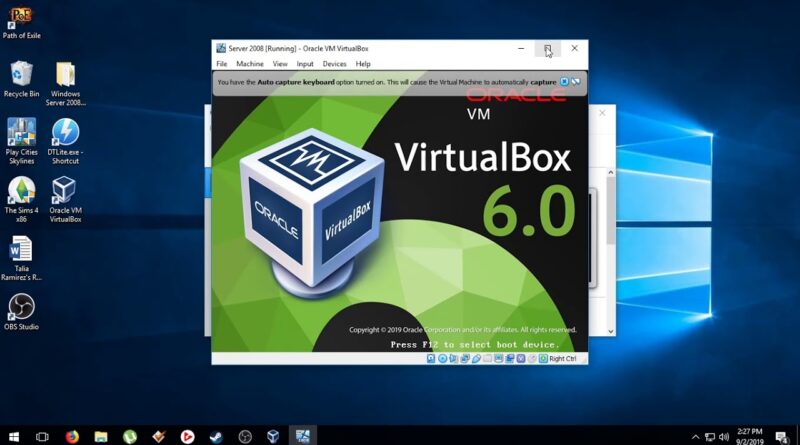

- LOADING WINDOWS IN A VIRTUALMACHINE HOW TO
- LOADING WINDOWS IN A VIRTUALMACHINE FULL
- LOADING WINDOWS IN A VIRTUALMACHINE WINDOWS 10
- LOADING WINDOWS IN A VIRTUALMACHINE SOFTWARE
If the value is 3:1 – there should be no reason to worry. The CPU overcommitment parameter is the ratio of the number of virtual processors assigned to VMs to the number of physical CPU cores on the host. VMware provides techniques for rational resource usage, allowing you to provision more virtual processors for VMs than there are physical CPU cores on the host. Sometimes, this feature can affect VM performance when the VM needs to use a disk for a swap.ĬPU overcommitment.

Memory overcommitment makes sense in test environments.Īlso, check memory ballooning and configuration of this feature to reclaim unused memory from VMs for efficient utilization of physical memory. If some VMs are running, but they are lightly loaded, memory is primarily used by the VMs that are heavily loaded because ESXi improves memory utilization. If you have a host with 8 GB of RAM and run five VMs configured to use 2 GB of RAM each, all VMs and the host machine can show low performance because the memory is overcommitted (if all VMs are using memory intensively). Memory overcommitment is a situation when total resource allocation exceeds capacity. If you run heavy applications such as databases on virtual machines, adjust VM configuration and add more CPU and memory resources accordingly. If you provide 6 GB of RAM for a Windows Server 2019 VM, the amount of memory for the host machine is not enough, and, as a result, both physical and virtual machines are slow. If you provide 2 GB of RAM for a VM running Windows Server 2019, in this case, VM performance would be slow. The ratio is 1:2 (4 GB/8 GB), and 1/2-1=-0.5 is the current MEM overcommit avg value. That is enough for proper work of both host OS and guest OS (without running additional applications that consume resources). If you provision 4 GB of RAM for a Windows Server 2019 VM, 4 GB of RAM is left for the host OS. A Windows Server 2019 VM is running on this host machine.
LOADING WINDOWS IN A VIRTUALMACHINE WINDOWS 10
Your host machine has 8 GB of memory and runs ESXi 7.0 or Windows 10 with VMware Workstation.

Read system requirements for your operating system and applications.

Always provide the host with enough memory. Don’t assign too much memory to a VM, and, at the same time, leave some for the host. Moreover, VM performance degrades as well in this case. This leads to the degradation of OS and application performance. If you provide a big amount of memory for a VM and don’t leave enough memory for the host OS, then the host OS uses a swap file. If you don’t provide enough memory for a VM, the guest OS (operating system) uses a swap file intensively, and overall VM performance is slow. At the same time, there must be enough RAM for a host machine. When you set the amount of RAM for a virtual machine, make sure that this amount of RAM is enough for the VM. Also, consider upgrading the hardware of your host machine if you have an old processor with a low number of cores, cache, and low frequency. To fix this, set a VM to use more CPU cores or add more virtual processors.
LOADING WINDOWS IN A VIRTUALMACHINE SOFTWARE
If you don’t provide enough CPU resources for a VM, software inside the VM might run slowly with lags. Insufficient hardware resources are among the most popular reasons for slow VM performance. Running applications are not responding.Applications take a lot of time to launch.But when you migrate a VM to another host, the performance of applications is normal. Applications run slower than they should.Virtual machine performance is slower than the performance of an identical VM on another host.Let’s look at the main reasons to perform diagnostics and improve VM performance:
LOADING WINDOWS IN A VIRTUALMACHINE HOW TO
Read about the most common issues that cause low virtual machine performance, and find recommendations on how to fix them and improve VM performance. This blog post explains how to improve virtual machine performance if VM performance is slow on the VMware virtualization platform. Reasons for that vary and may be the result of hardware or software issues. Using virtual machines is convenient and efficient, but sometimes VM performance degrades.
LOADING WINDOWS IN A VIRTUALMACHINE FULL
By Michael Bose A Full Overview of VMware Virtual Machine Performance Problems


 0 kommentar(er)
0 kommentar(er)
